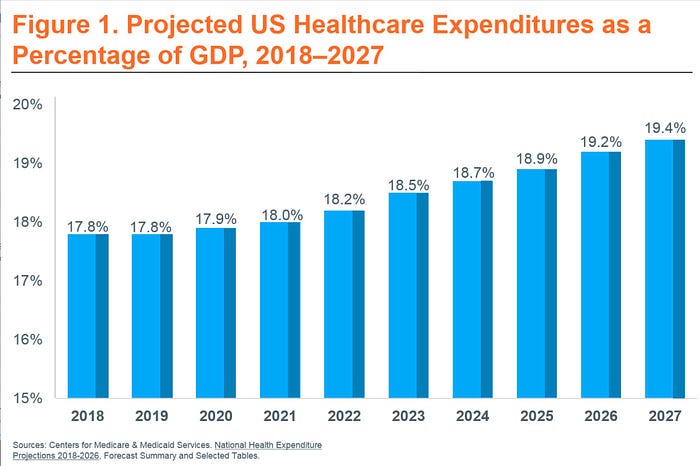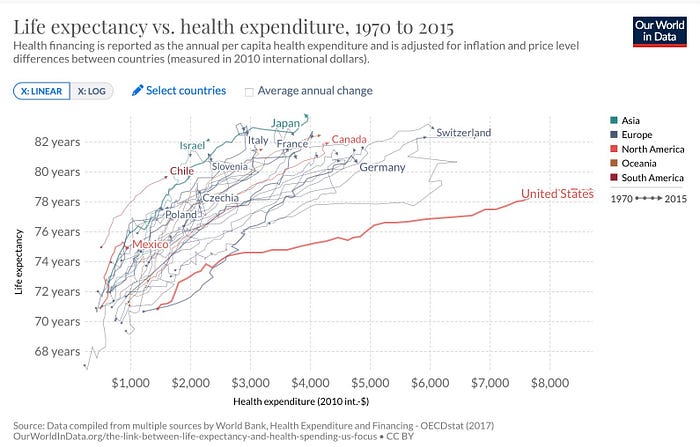

Apple Search For The Next Big Thing: Healthcare
source link: https://mondaynote.com/apple-search-for-the-next-big-thing-healthcare-ad9ba33af92d
Go to the source link to view the article. You can view the picture content, updated content and better typesetting reading experience. If the link is broken, please click the button below to view the snapshot at that time.
Apple Search For The Next Big Thing: Healthcare
by Jean-Louis Gassée

Continuing the search for Apple’s next growth wave, one of iPhone proportions, we turn this week to a possible Mother Lode: Healthcare.
Without getting into a politically charged discussion of our healthcare system, kindly direct your attention to Max Roser’s immensely valuable Our World In Data website. When we search for “US Healthcare”, one of the top hits is a page entitled Link between health spending and life expectancy: The US is an outlier. You can read the page and somberly meditate upon child and maternal mortality. For today, I’ll just insert a graph that plots life expectancy vs. health expenditure:

As one of our brothers-in-Be liked to say: It Costs More, But It Does Less.
In absolute terms, according to the Wall Street Journal, our country’s healthcare spending was about $4.3T (as in trillion) in 2021. By comparison, US auto industry revenue was “just” $1.2T in 2020. A huge opportunity must await the Cupertino company!
But, no, this is a dubious juxtaposition. The country’s enormous healthcare expenditure includes doctors, hospitals, drugs, etc., none of which is accessible to Apple. Calling healthcare a Mother Lode that beckons the Apple miners is to be blinded by the immensity of our outlays.
To be sure, the company dabbles in the healthcare field. The Apple Watch monitors heart rate and blood oxygen, it provides alerts for hard falls and atrial fibrillation. Other opportunities surely haven’t escaped Apple’s attention. For example, measuring body temperature might be feasible without a technological breakthrough.
Unfortunately, an easy, portable means for detecting our two worst “silent killers”, high blood pressure and diabetes, may be impossible due to the physical requirements of the monitoring devices.
While many companies sell home blood pressure monitors, and a company called Omron even offers the wearable HeartGuide, there seems to be no alternative to the age-old blood pressure monitoring process. How does HeartGuide do it? It has “an inflatable cuff within the watch band to take a blood pressure reading.” Will the design and ergonomics (and price) of the Apple Watch accommodate an inflatable band?
Regarding diabetes, in 2017 the cost of the disease reached $327B and grows steadily year after year. Wouldn’t it be nice to have an Apple Watch monitor our blood sugar content? As with blood pressure monitoring, surveilling the sugar content of our blood would save lives and money, the latter to be shared in appropriate proportions with device makers such as Apple. Unfortunately, the state of the art requires piercing one’s skin, not something one sees Apple engaging in.
But perhaps there is a healthcare opportunity that warrants the Jeff Bezos mantra, Your Margin Is My Opportunity. I’m referring to hearing aids — and I speak from personal experience. My 78-year-old ears have become muffled, enough to confound conversations in noisy restaurants and to make boisterous family gatherings difficult and painful. The attendant social withdrawal is neither pleasant nor healthy, it damages one’s quality of life and function of mind.
Following my doctor’s advice and my family’s urging, I was thoroughly tested by a local audiologist, a process that, interestingly, involves more than just plotting frequency-response curves. With the goal of providing a therapy that would enhance conversation, I listened to a variety of words — in English and French — at different loudness levels. (Not entirely surprisingly, even after four decades living in California, I easily understand French TV without assistance and detect the widely varying sound quality on streaming programs.)
I ended up buying a top-of-the line hearing aid for a little more than $7K. I was initially pleased with the results, group conversations were easier and I could use a supplied iPhone (or Android) app to adapt to sonic circumstances. I quickly became used to wearing the unobtrusive devices, so much so that I lost the left one in a French hypermarché parking lot while removing a Covid mask. (Part of the purchase price included loss insurance with a $600 deductible.)
After a while, however, I started to notice that while conversations were clearer, the sound quality was only so-so. It was particularly mediocre when playing audiobooks from my iPhone on my walks around Palo Alto, so much so that I switched to AirPods and was rewarded with a significantly better experience.
This got me thinking: What could Apple do in the hearing enhancement field?
When I mentioned Apple to my audiologist during a visit to fix an annoying howling feedback bug, the individual told me Apple was indeed hiring audiologists. This increased my longing for an Apple solution: More sophisticated microelectronics, directional microphones, coordination between in-device and on-iPhone software, much better sound quality.
There is, of course, the delicate question of FDA approval — a difficult hurdle, even for a company such as Apple — but here’s the beginning of the story’s next chapter: The FDA just blessed the sale of over-the-counter hearing aids. Starting next October, you’ll go to the corner drugstore and buy hearing aids the way you buy reading glasses.
Audiologists take this incursion into their area of expertise (and income) very seriously. Only days ago, my local hearing aid supplier held a seminar to discuss the benefits of a visit to your professional audiology expert versus the coming over-the-counter solutions. I’ll certainly look for the latter come next month.
Back to Apple and healthcare opportunities, hearing loss is the third most common chronic physical condition that affects people of all ages, after arthritis and heart disease. According to the National Institute on Deafness and Other Communication Disorders:
“Approximately one in three people in the United States between the ages of 65 and 74 has hearing loss, and nearly half of those older than 75 have difficulty hearing.”
For Apple, this is a sizable “Doing Well While Doing Good” market, one that doesn’t seem to require a Holy Grail technology breakthrough, just doing more of what it already does well. And the Jeff Bezos’ margin incantation keeps ringing in my ears (so to speak): There’s a lot of room between a $249 pair of AirPod Pros and a $7K pair of Resound “amplification” devices.
But I must listen to my own caution: I may be blinded by healthcare’s enormous (and not always well-spent) sums. As large as the market could be, an AirPod hearing aid probably isn’t where Apple’s Next Big Thing resides. We may see some neat advances, but no iPhone-caliber development.
More generally, Healthcare isn’t where Apple will find its Next Big Thing.
In a coming Monday Note, we’ll look at what this means for Apple’s future.
Recommend
About Joyk
Aggregate valuable and interesting links.
Joyk means Joy of geeK